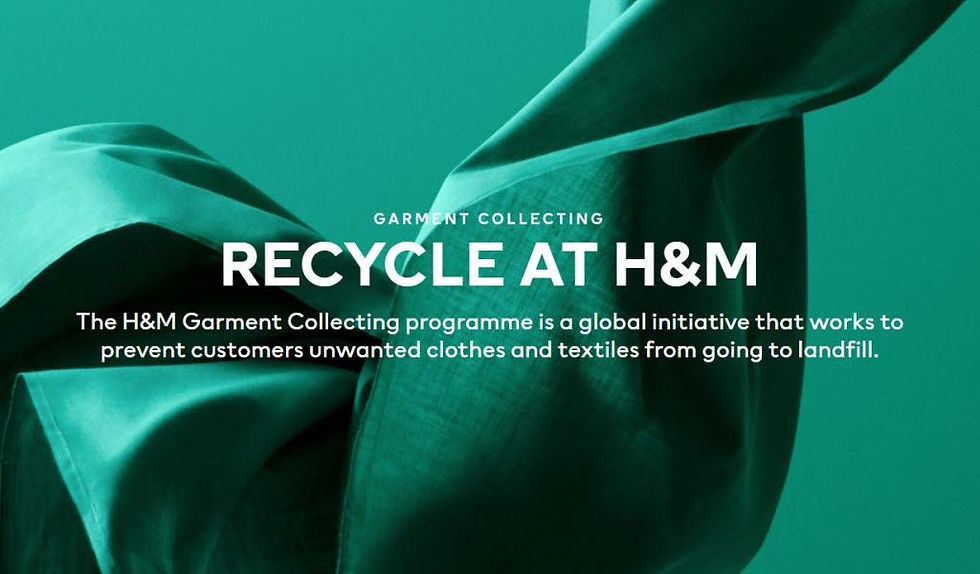H&M and Its Greenwashing History
- S. Oyku Ince
- Jul 8, 2022
- 3 min read
Greenwashing may be a word that you have never heard before in your life. For starters, “greenwashing is the process of conveying a false impression or providing misleading information about how a company’s products are more environmentally sound” and “is “considered an unsubstantiated claim to deceive consumers into believing that a company’s products are environmentally friendly” (Kenton). After reading the meaning of greenwashing you can realize that, on a daily basis, you are being greenwashed. We do not always notice it. H&M is a great example of a greenwasher brand. Greenwashing became one of the most used marketing strategies.
H&M has been accused of greenwashing for a few years now (See “H&M and Greenwashing”). I heard about it for the first time when I was a new activist, and since then, I have not purchased anything from H&M. Recently, H&M decided not to continue with their product labeling tool because people were calling them out. After reading this news, I thought this article was needed.

"H&M and Greenwashing”
H&M’s Conscious Program
Do you remember H&M’s Conscious Collection 2019 and how the company advertised it? Their motto was to dress for a sustainable fashion future, and they had an advertisement clip. You can access the clip through this link. While watching the clip, the beauty of nature is quite striking. Mountains, fields, trees, flowers, and the sky… They are just beautiful. And H&M persuades us to show love to the planet because, according to the advertisement, it also shows love and care. This idea is the main message of the entire thirty seconds. Below the clip, H&M has an explanation: H&M are proud that the entire collection has been made from sustainably-sourced materials, which not only emphasizes the H&M Group’s status as one of the world’s largest users of organic cotton, Tencel, and recycled polyester but also shows the continued efforts, commitment, and progress we are making for a sustainable fashion future. But in fact, the Conscious Collection “contain[ed] a higher proportion of synthetic fibers than its fast-fashion line” (Ho). Particularly, the collection mostly contains polyester. Polyester is a concerning fabric since it can release chemicals when in contact with the skin. Chemicals from polyester can mix in the air (“The Dangers Of Polyester And Why Bearaby Went Natural.” ).
Synthetic fibers are an environmental issue because their production relies on fossil fuels. They contain microplastics (as the latest research has shown microplastics can be found in human blood). They are non-biodegradable, and their breaking down in nature can last up to 1000 years. And at the end of the day, they contribute to the pollution. They are toxic. They contain a risk for marine life and other habitats. Since many microplastics end up in most of our water, they threaten our lives. In the North Pole and Antarctica, synthetic fibers have been found (“PROBLEMS WITH SYNTHETIC FABRICS.”)
Recycling Program
H&M is not only partaking in the greenwashing by their collection. According to the Synthetics Anonymous report, written by Changing Markets Foundation, 96% of H&M’s claims about their sustainability are misleading or not transparent (Synthetics Anonymous Fashion brands’ addiction to fossil fuels). After learning about the %96, a question might arise in your head: was the recycling program of H&M part of their greenwashing (See “H&M Recycling Program”). Unfortunately, it is. They are not being transparent about their program. Consumers do not know how much of the clothes they have contributed are recycled and how they are recycled. We do not have any numbers.

"H&M Recycling Program”
Hopefully, after reading this article, you are more aware of greenwashing. Throughout the article, H&M’s partake in greenwashing was given as a simple and great example. But, it is important to keep in mind that H&M is not the only company or brand that partakes in greenwashing. As mentioned, many worldwide well-known companies/brands use greenwashing as a marketing strategy. As consumers, we should be careful and responsible about where we support. We can choose to support local small and transparent businesses over the greenwashing ones. This way, we can do our part and show our affection for the planet.
Works Cited
"The Dangers Of Polyester And Why Bearaby Went Natural." Bearaby, 2020, bearaby.com/blogs/the-lay-low/the-dangers-of-polyester-and-why-bearaby-went-natural#:~:text=Polyester%20fabric%20releases%20chemicals%20like,some%20more%20direct%20health%20concerns. Accessed 3 July 2022.
H&M and Greenwashing. miro.medium.com/max/620/0*32CFJKGahP9F-Vw3. Accessed 3 July 2022.
"H&M Conscious Collection 2019: Dress for a sustainable fashion future." YouTube, uploaded by H&M, www.youtube.com/watch?v=Xkx0mjFv-i4. Accessed 3 July 2022.
H&M Recycling Program. www.chargedretail.co.uk/wp-content/uploads/2020/01/HM-Recycling_SS-1024x683.jpg. Accessed 3 July 2022.
Ho, Sally. "Nearly 60% of Sustainable Fashion Claims Are Greenwashing, Report Finds." green queen, 10 July 2021, www.greenqueen.com.hk/fashion-brands-sustainability-claims-greenwashing/. Accessed 3 July 2022.
Kenton, Will. "Greenwashing." Investopia, 22 Mar. 2022, www.investopedia.com/terms/g/greenwashing.asp. Accessed 3 July 2022.
"PROBLEMS WITH SYNTHETIC FABRICS." MOVEMETICA, 24 Oct. 2020, movemetica.com/blogs/news/problems-with-synthetic-fabrics#:~:text=Clothing%20that%20contains%20synthetic%20fibres,it%20comes%20from%20synthetic%20fabrics. Accessed 3 July 2022.
Synthetics Anonymous Fashion brands' addiction to fossil fuels. changingmarkets.org/wp-content/uploads/2021/07/SyntheticsAnonymous_FinalWeb.pdf. Accessed 3 July 2022.